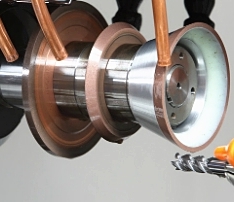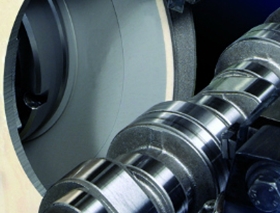

Selection of Grinding wheel Hardness:
Grinding wheel hardness is an important index to measure the "self-sharpening" of grinding wheel.
In the grinding process, the abrasive gradually becomes blunt and sharp, and the partially passivated abrasive continues to work, and the pressure on the abrasive will continue to increase. When the pressure is high to a certain value, some abrasive grains will be broken and form a new edge. When the pressure exceeds the bonding force of the binder, the abrasive particles will be self-detached. The property that the passivated abrasive grains will collapse or fall off themselves, keeping the wheel sharp, is called "self-sharpness". The hardness of grinding wheel reflects the degree of difficulty that the abrasive particles fall off from the surface of grinding wheel under the action of grinding force. The grinding wheel is hard, that is, the abrasive particles are difficult to fall off; If the grinding wheel is soft, the abrasive grains fall off easily.
The hardness of grinding wheel and the hardness of abrasive grain are two different concepts:
It is not that the hardness of diamond grinding wheel must be high, and the abrasive of ordinary abrasive brown corundum must be low.
Use English letters to indicate the grinding wheel hardness grade: A B C D E F G H I J K L M N P Q.......
Hardness is usually K-P in ascending order.

Grinding wheel hardness is hard, blunt abrasive particles are not easy to fall off, grinding wheel is easy to plug, grinding heat increases, the workpiece is easy to burn, grinding efficiency is low, affecting the surface quality of the workpiece.
The grinding wheel is too hard and soft, and the grinding grain will fall off when it is still sharp, which increases the grinding wheel loss, easily loses the correct geometry, and affects the accuracy of the workpiece.
Therefore, the selection of grinding wheel hardness should be appropriate, and should be considered comprehensively according to the contact area between grinding wheel and workpiece, workpiece shape, grinding mode, cooling mode, grinding wheel bond type and other factors.


When choosing grinding wheel hardness, the following principles can be referred to:
1. Hardness of workpiece
The harder the workpiece material is, the hardness of the grinding wheel should be selected to be soft, so that the dull abrasive particles can fall off quickly, so that the grinding wheel often keeps sharp abrasive particles working, and avoids the workpiece being burned due to the high grinding temperature. The softer the workpiece material, the harder the grinding wheel hardness should be selected, so that the abrasive particles fall off slowly, in order to give full play to the cutting role of the abrasive particles.
2. Processing contact surface
When the grinding wheel has a large contact surface with the workpiece, soft grinding wheel should be used to make the abrasive particles fall off faster, so as to avoid the workpiece surface burn caused by grinding dust blocking the grinding wheel surface. The hardness of grinding wheel should be lower than that of outer grinding wheel for inner grinding and end grinding. When grinding thin-wall parts and workpiece with poor thermal conductivity, the hardness of grinding wheel should also be lower.
3. Fine grinding and form grinding
Hardness of workpieceIn fine grinding and form grinding, a harder grinding wheel should be selected to maintain the necessary shape accuracy of the grinding wheel.
4. Grain size of grinding wheel
The larger the grain size of grinding wheel is, the hardness should be lower, so as to avoid the grinding wheel surface structure blocked by dust.
5. Workpiece Material Section
When grinding non-ferrous metals, rubber, resin and other soft materials, a soft grinding wheel should be selected to avoid the grinding wheel surface blocked by dust.
6. Under the same grinding conditions
The hardness of resin bonded grinding wheel is 1-2 times that of ceramic bonded grinding wheel.
7.The hardness of grinding wheel can be 1~2 grades soft
8. Grind with coolant
The hardness of grinding wheel is 1-2 small grades higher than that of dry grinding.
In grinding, the hardness of grinding wheel is K to N. Q grinding wheel can be used to grind stone and hard material when grinding steel ingot and castings. Soft grinding wheels have better "self-sharpening", which can improve grinding performance and reduce grinding force and grinding heat. Generally, k-L is used. When grinding hard materials, abrasive grains are easy to passivate, so soft grinding wheel should be selected to make grinding wheel sharp; When grinding soft materials, grinding wheels are not easy to be passivated, so hard grinding wheels should be used to avoid premature shedding and loss of abrasive particles. When grinding especially soft and tough materials, the grinding wheel is easy to jam, so soft grinding wheel can be used.
----EDITOR:Doris Hu
----POST:Yvonne Feng
Semiconductor Industry Solutions
PCD & PCBN Tools Grinding Industry
Diamond Cutting Bruting Polishing
Add: No.171 Zhongyuan Rd, Zhongyuan District, Zhengzhou, 450001, Henan, China
Tel: +86-371-86545906
Phone / Whats App: +86 18339903057
E-mail: [email protected]



